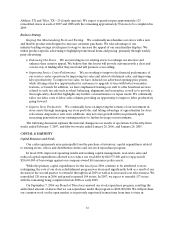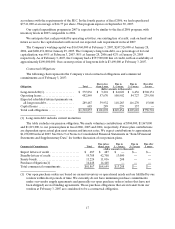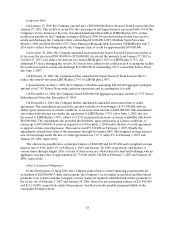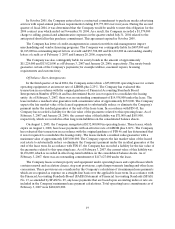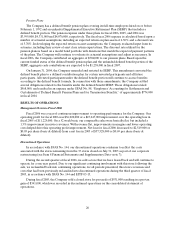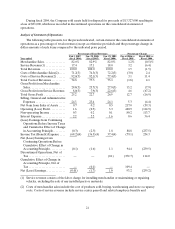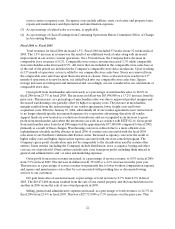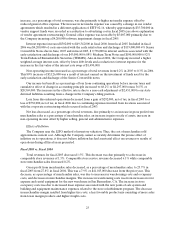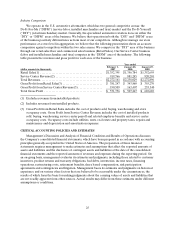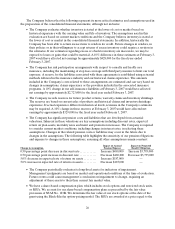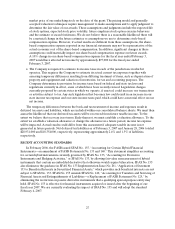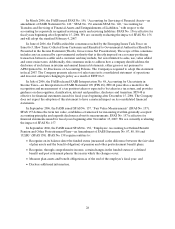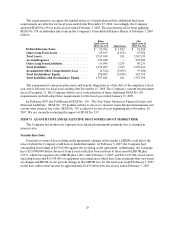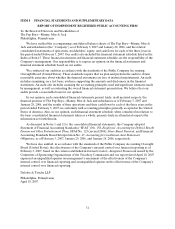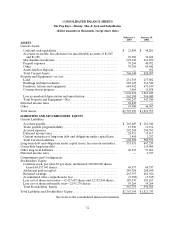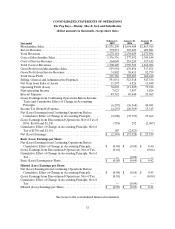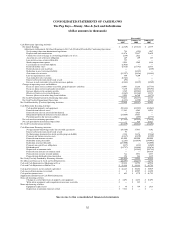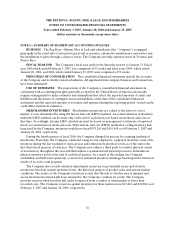Pep Boys 2006 Annual Report Download - page 65
Download and view the complete annual report
Please find page 65 of the 2006 Pep Boys annual report below. You can navigate through the pages in the report by either clicking on the pages listed below, or by using the keyword search tool below to find specific information within the annual report.
26
The Company believes that the following represent its more critical estimates and assumptions used in
the preparation of the consolidated financial statements, although not inclusive:
•The Company evaluates whether inventory is stated at the lower of cost or market based on
historical experience with the carrying value and life of inventory. The assumptions used in this
evaluation are based on current market conditions and the Company believes inventory is stated at
the lower of cost or market in the consolidated financial statements. In addition, historically the
Company has been able to return excess items to vendors for credit. Future changes in vendors, in
their policies or in their willingness to accept returns of excess inventory could require a revision in
the estimates. If our estimates regarding excess or obsolete inventory are inaccurate, we may be
exposed to losses or gains that could be material. A 10% difference in these estimates at February 3,
2007 would have affected net earnings by approximately $428,000 for the fiscal year ended
February 3, 2007.
•The Company has risk participation arrangements with respect to casualty and health care
insurance, including the maintaining of stop loss coverage with third party insurers to limit our total
exposure. A reserve for the liabilities associated with these agreements is established using actuarial
methods followed in the insurance industry and our historical claims experience. The amounts
included in the Company’s costs related to these arrangements are estimated and can vary based on
changes in assumptions, claims experience or the providers included in the associated insurance
programs. A 10% change in our self-insurance liabilities at February 3, 2007 would have affected
net earnings by approximately $2,723,000 for the fiscal year ended February 3, 2007.
•The Company records reserves for future product returns, warranty claims and inventory shrinkage.
The reserves are based on current sales of products and historical claims and inventory shrinkage
experience. If actual experience differs from historical levels, revisions in the Company’s estimates
may be required. A 10% change in these reserves at February 3, 2007 would have affected net
earnings by approximately $329,000 for the fiscal year ended February 3, 2007.
•The Company has significant pension costs and liabilities that are developed from actuarial
valuations. Inherent in these valuations are key assumptions including discount rates, expected
return on plan assets, mortality rates and merit and promotion increases. The Company is required
to consider current market conditions, including changes in interest rates, in selecting these
assumptions. Changes in the related pension costs or liabilities may occur in the future due to
changes in the assumptions. The following table highlights the sensitivity of our pension obligations
and expense to changes in these assumptions, assuming all other assumptions remain constant:
Change in Assumption
Impact on Annual
Pension Expense
Impact on Projected
Benefit Obligation
0.50 percentage point decrease in discount rate . . . . . . . . . . . . Increase $480,000 Increase $3,795,000
0.50 percentage point increase in discount rate . . . . . . . . . . . . Decrease $480,000 Decrease $3,795,000
5.0% decrease in expected rate of return on assets . . . . . . . . . Increase $187,000 —
5.0% increase in expected rate of return on assets. . . . . . . . . . Decrease $187,000 —
•The Company periodically evaluates its long-lived assets for indicators of impairment.
Management’s judgments are based on market and operational conditions at the time of evaluation.
Future events could cause management’s conclusion on impairment to change, requiring an
adjustment of these assets to their then current fair market value.
•We have a share-based compensation plan, which includes stock options and restricted stock units,
or RSUs. We account for our share-based compensation plans as prescribed by the fair value
provisions of SFAS No. 123R. We determine the fair value of our stock options at the date of the
grant using the Black-Scholes option-pricing model. The RSUs are awarded at a price equal to the


